service schedule BUICK LESABRE 1993 Owners Manual
[x] Cancel search | Manufacturer: BUICK, Model Year: 1993, Model line: LESABRE, Model: BUICK LESABRE 1993Pages: 324, PDF Size: 17.02 MB
Page 11 of 324
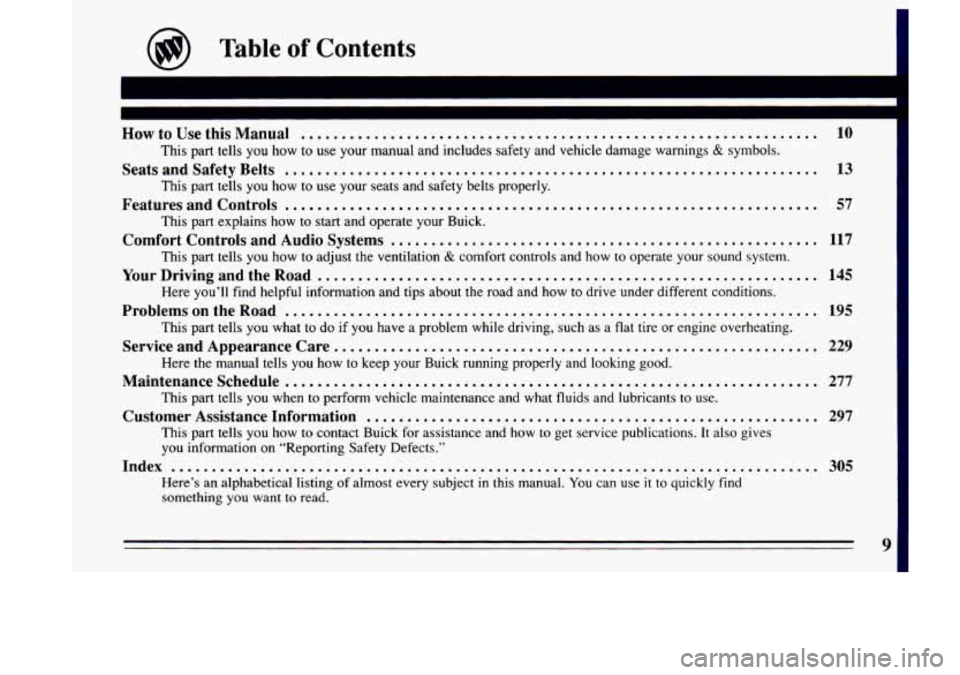
How to Use this Manual ................................................................
This part tells you how to use your manual and includes safety and vehicle damage warnings & symbols.
SeatsandSafetyBelts ..................................................................
This part tells you how to use your seats and safety belts properly.
Featuresandcontrols ..................................................................
This part explains how to start and operate your Buick.
Comfort Controls and Audio Systems .....................................................
This part tells you how to adjust the ventilation & comfort controls and how to operate your sound system.
YourDrivingandtheRoad ..............................................................
Here you’ll find helpful information and tips about the road and how to drive under different conditions.
ProblemsontheRoad ..................................................................
This part tells you what to do if you have a problem while driving, such as a flat tire or engine overheating.
ServiceandAppearanceCare ............................................................
Here the manual tells you how to keep your Buick running properly and looking good.
Maintenanceschedule ..................................................................
This part tells you when to perform vehicle maintenance and what fluids and lubricants to use.
Customer Assistance Information ........................................................
This part tells you how to contact Buick for assistance and how to get service publications. It also gives
you information on “Reporting Safety Defects.”
Index ........................................................................\
........
Here’s an alphabetical listing of almost every subject in this manual. You can use it to quickly find
something you want
to read.
(@ Table of Contents
9
10
13
57
117
145
195
229
277
297
305
Page 196 of 324
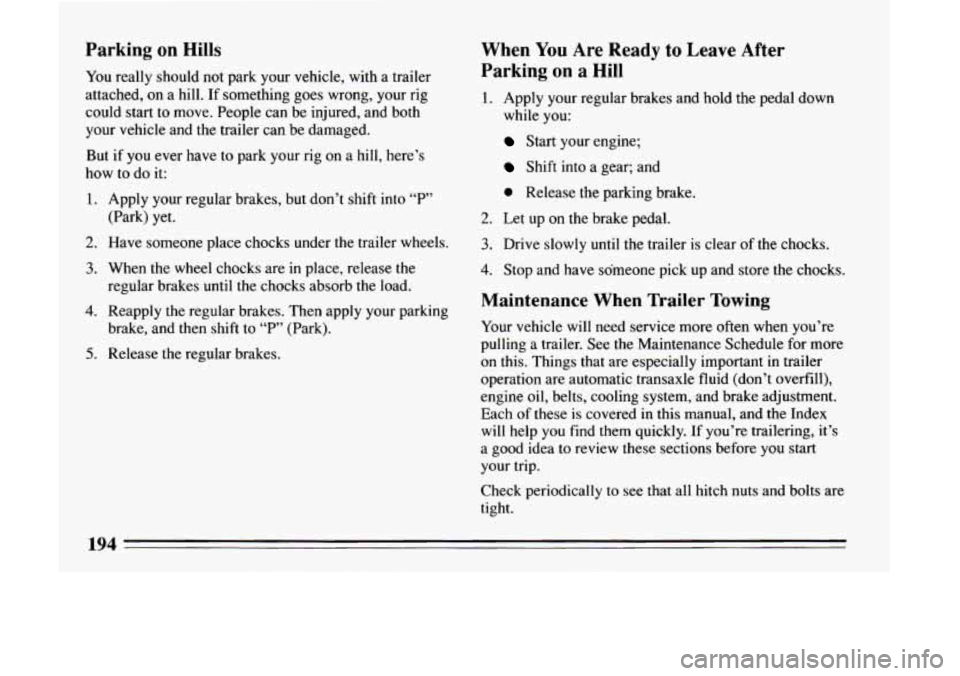
Parking on Hills
You really should not park your vehicle, with a trailer
attached, on a hill. If something goes wrong, your rig
could start to move. People can be injured, and both
your vehicle and the trailer can be damaged.
But if you
ever have to park your rig on a hill, here’s
how to do it:
1. Apply your regular brakes, but don’t shift into “P7’
(Park) yet.
2. Have someone place chocks under the trailer wheels.
3. When the wheel chocks are in place, release the
regular brakes until the chocks absorb the load.
4. Reapply the regular brakes. Then apply your parking
brake, and then shift to
“P” (Park).
5. Release the regular brakes.
When You Are Ready to Leave After
Parking
on a Hill
1. Apply your regular brakes and hold the pedal down
while you:
Start your engine;
Shift into a gear; and
0 Release the parking brake.
2. Let up on the brake pedal.
3. Drive slowly until the trailer is clear of the chocks.
4. Stop and have someone pick up and store the chocks.
Maintenance When Trailer Towing
Your vehicle will need service more often when you’re
pulling a trailer. See the Maintenance Schedule for more
on this. Things that are especially important in trailer
operation are automatic transaxle fluid (don’t overfill),
engine oil, belts, cooling system, and brake adjustment.
Each of these is covered
in this manual, and the Index
will help you find them quickly. If you’re trailering, it’s
a good idea to review these sections before you
start
your trip.
Check periodically to see that all hitch nuts and bolts are
tight.
194
Page 243 of 324
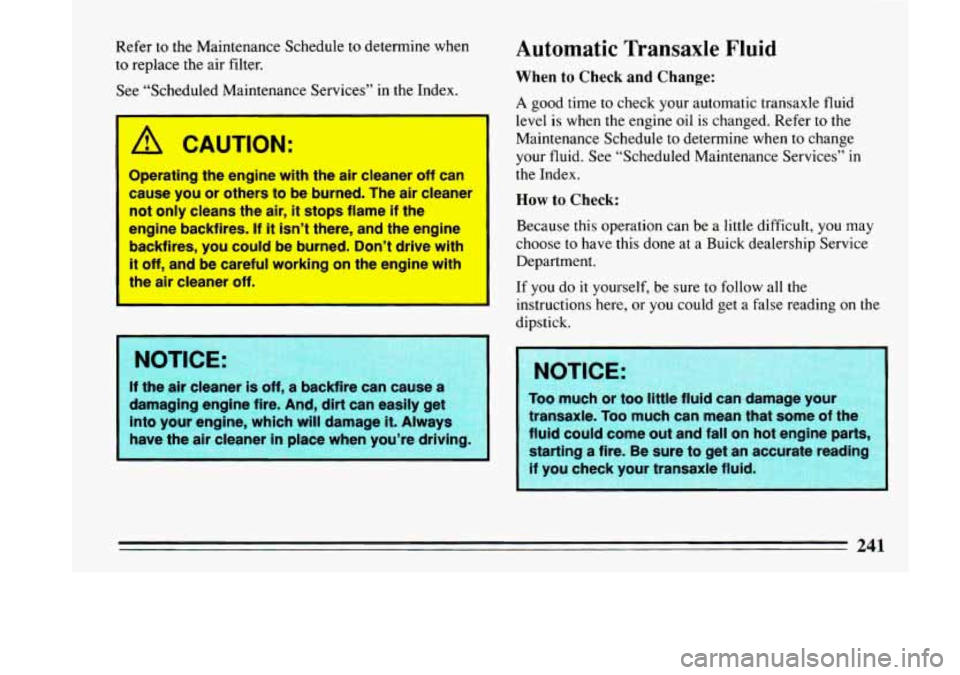
Refer to the Maintenance Schedule to determine when
to replace the air filter.
See “Scheduled Maintenance Services” in the Index.
A CAUTION:
Operating the engine with the air cleaner off can
cause you or others
to be burned. The air cleaner
not only cleans the air, it stops flame if the
engine backfires.
If it isn’t there, and the engine
backfires, you could be burned. Don’t drive with
it off, and be careful working on the engine with
the
air cleaner off.
I
NOTICE:
If the air cleaner is off, a backfire can cause a
damaging engine fire. And, dirt can easily gel
into your engine, which wiil damage
it. Always
have the air cleaner
in place when you’re driving.
Automatic Transaxle Fluid
When to Check and Change:
A good time to check your automatic transaxle fluid
level
is when the engine oil is changed. Refer to the
Maintenance Schedule to determine when to change
your fluid. See “Scheduled Maintenance Services”
in
the Index.
How to Check:
Because this operation can be a little difficult, you may
choose to have this done at a Buick dealership Service
Department.
If you do it yourself, be sure to follow all the
instructions here,
or you could get a false reading on the
dipstick.
241
Page 259 of 324
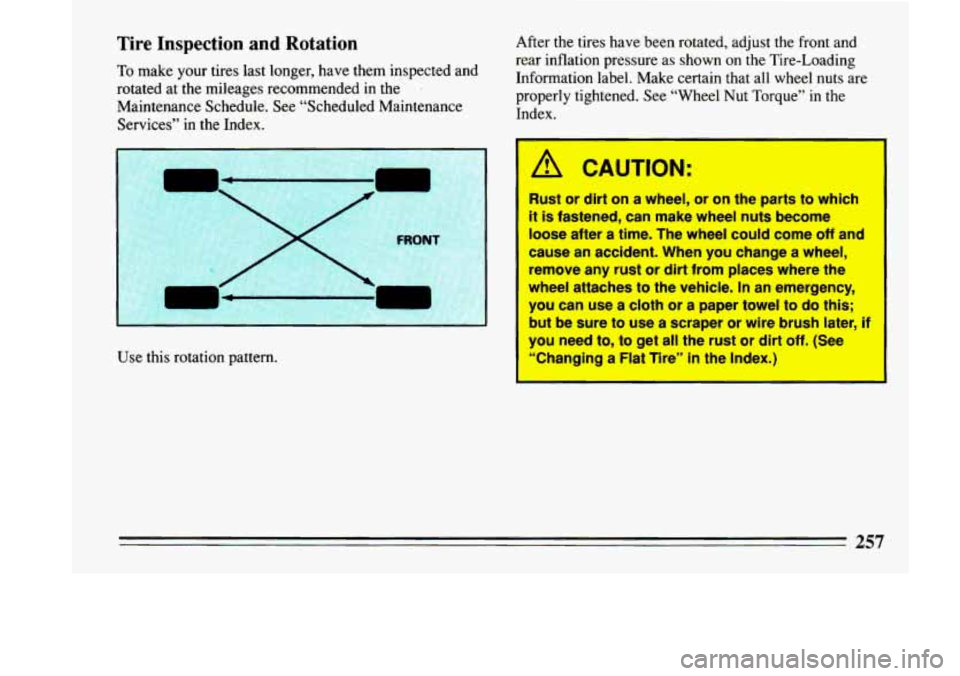
Tire Inspection and Rotation
To make your tires last longer, have them inspected and
rotated at the mileages recommended in the
.
Maintenance Schedule. See “Scheduled Maintenance
Services’’ in the Index.
Use this rotation pattern. After
the tires have been rotated, adjust the front and
rear inflation pressure as shown on the Tire-Loading
Information label. Make certain that all wheel nuts are
properly tightened. See “Wheel Nut Torque” in the
Index.
I
A CAUTION:
Rust or dlrt on a wheel, or on the parts to which
it is fastetfed, can make wheel nuts become
loose after a time. The wheel could come off and
cause
an accident. When you change a wheel,
remove any rust or dirt from places where the
wheel attaches
to the vehicle. In an emergency,
you can use a cloth or a paper towel to do this;
but be
sure to use a scraper or wire brush later, if
you need to, to get all the rust or dirt off. (See
“Changing a FI; Tire’* On the Index.)
Page 279 of 324
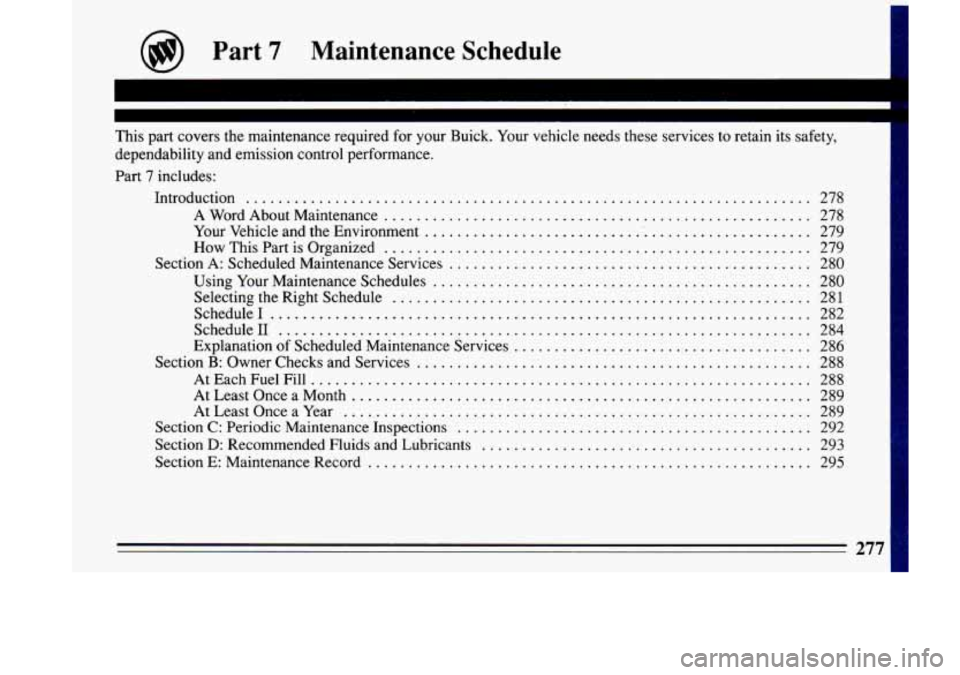
This part covers the maintenance required for your Buick . Your vehicle needs these services to retain its safety.
dependability and emission control performance
.
Part 7 includes:
Introduction
...................................................................... 278
A Word About Maintenance
..................................................... 278
Your Vehicle and the Environment
................................................. 279
Section A: Scheduled Maintenance Services
............................................. 280
Using Your Maintenance Schedules
............................................... 280
Selecting the Right Schedule
.................................................... 281
Schedule1
................................................................... 282
Schedule11
.................................................................. 284
Explanation of Scheduled Maintenance Services ..................................... 286
Section
B: Owner Checks and Services ................................................. 288
AtEachFuelFill
.............................................................. 288
AtLeastOnceaMonth
......................................................... 289
AtLeastOnceaYear
.......................................................... 289
Section
C: Periodic Maintenance Inspections ............................................ 292
Section
D: Recommended Fluids and Lubricants ......................................... 293
Section
E: Maintenance Record ....................................................... 295
How
This Part is Organized
..................................................... 279
277
Page 281 of 324
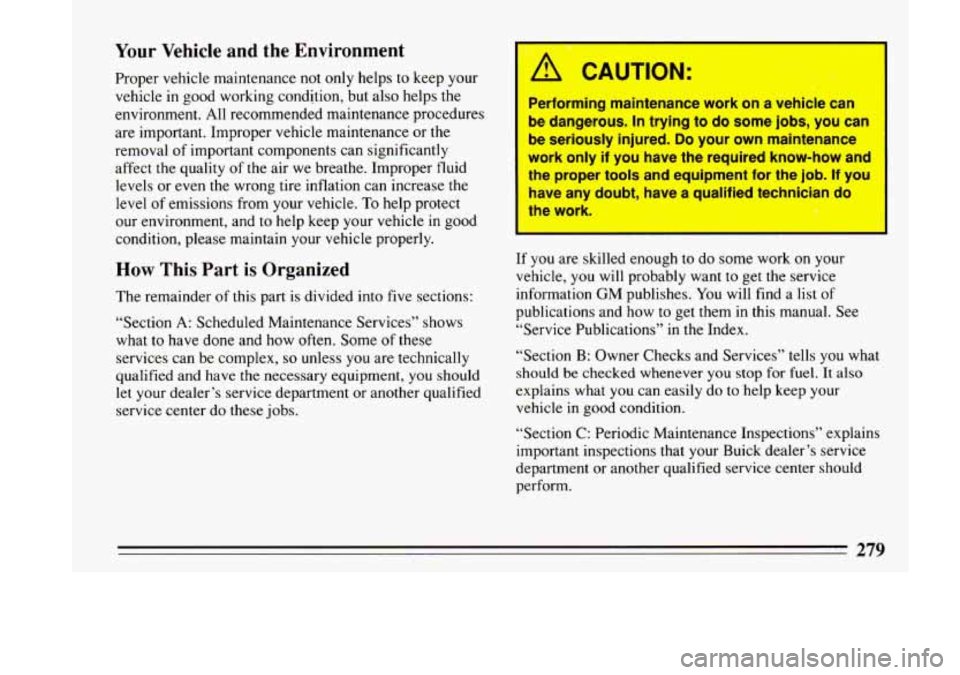
* Your Vehicle and the Environment
Proper vehicle maintenance not only helps to keep your
vehicle in good working condition, but also helps the
environment. All recommended maintenance procedures
are important. Improper vehicle maintenance or the
removal of important components can significantly
affect the quality
of the air we breathe. Improper fluid
levels or even the wrong tire inflation can increase the
level of emissions from your vehicle.
To help protect
our environment, and to help keep your vehicle in good
condition, please maintain your vehicle properly.
How This Part is Organized
The remainder of this part is divided into five sections:
“Section
A: Scheduled Maintenance Services” shows
what
to have done and how often. Some of these
services can be complex,
so unless you are technically
qualified and have the necessary equipment,
you should
let your dealer’s service department or another qualified
service center do these
jobs.
A CAUTION:
1. *
._ 1. c
Performing maintenance work on a vehicle can
be dangerous. In trying to do some jobs, you can
be seriously injured.
Do your own maintenance
work only if you have the required know-how and the proper tools and equipment for the
job. If you
have any doubt, have a qualified technician do
the work.
If you are skilled enough to do some work on your
vehicle, you will probably want to get the service
information
GM publishes. You will find a list of
publications and how to get them in this manual. See
“Service Publications’’ in the Index.
“Section
B: Owner Checks and Services” tells you what
should
be checked whenever you stop for fuel. It also
explains what you can easily do to help keep your
vehicle in good condition.
“Section
C: Periodic Maintenance Inspections” explains
important inspe.ctions that your Buick dealer’s service
department or another qualified service center should
perform.
279
- .. ~ .. - .
Page 282 of 324
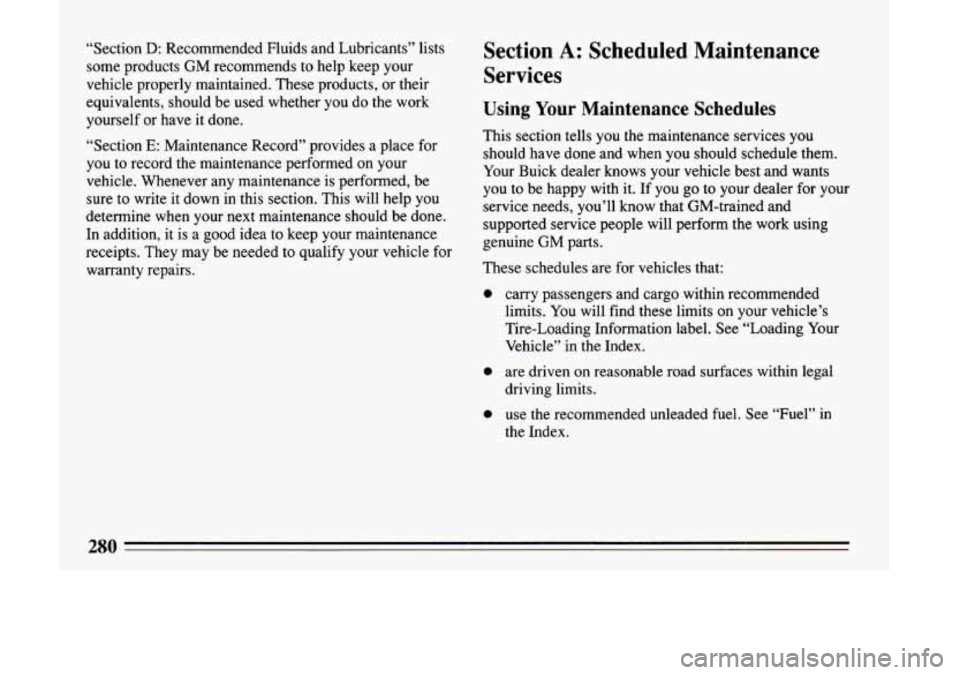
“Section D: Recommended Fluids and Lubricants” lists
some products GM recommends to help keep your
vehicle properly maintained. These products, or their
equivalents, should be used whether you do the work
yourself or have it done.
“Section
E: Maintenance Record” provides a place for
you to record the maintenance performed on your
vehicle. Whenever any maintenance is performed, be
sure to write it down in this section. This will help
you
determine when your next maintenance should be done.
In addition, it is a good idea to keep your maintenance
receipts. They may be needed to qualify your vehicle for
warranty repairs.
Section A: Scheduled Maintenance
Services
Using Your Maintenance Schedules
This section tells you the maintenance services you
should have done and when you should schedule them.
Your Buick dealer knows your vehicle best and wants
you to be happy with it. If you go to your dealer for your
service needs, you’ll know that GM-trained and
supported service people will perform the work using
genuine
GM parts.
These schedules are for vehicles that:
0 carry passengers and cargo within recommended limits. You will find these limits on your vehicle’s
Tire-Loading Information label. See “Loading Your
Vehicle” in the Index.
0 are driven on reasonable road surfaces within legal
driving limits.
0 use the recommended unleaded fuel. See “Fuel” in
the Index.
280
Page 284 of 324
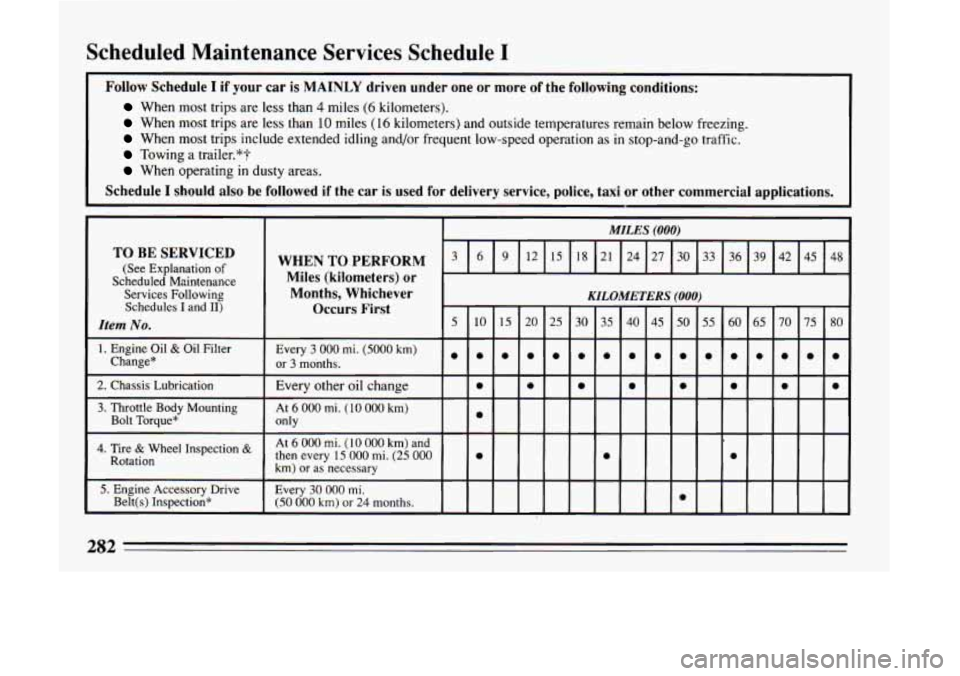
Scheduled Maintenance Services Schedule I
Follow Schedule I if your car is MAINLY driven under one .or more of the following conditions:
When most trips are less than 4 miles (6 kilometers).
When most trips are less than 10 miles (16 kilometers) and outside temperatures remain below freezing.
When most trips include extended idling and/or frequent low-speed operation as in stop-and-go traffic.
Towing a trailer.*?
When operating in dusty areas.
Schedule I should also be followed if the car is used for delivery service, police, taxi or other commercial applications.
I I MILES (000) ~ ~ ~~
TO BE SERVICED
Miles (kilometers) or
Scheduled Mzintenance
48 45 42 39
36
33 30 27
24 21 18 15 12 9 6 3 WHEN TO PERFORM (See Explanation of
~ ~~ ~~
Services Following
Schedules I and
11)
Months, Whichever
Occurs First
Item No.
1. Engine Oil & Oil Filter Every 3 000 mi. (5000 km)
Change* or
3 months.
2. Chassis Lubrication Every
other oil change
3. Throttle Body Mounting At 6 000 mi. (10 000 km)
~~
Bolt Torque*
only
4* Tire & Inspection & then every 15 000 mi. (25 000 At 6 000 mi. ( 10 000 km) and
km)
or as necessary
Rotation
5. Engine
Accessory Drive
Every 30 000 mi.
Belt(s) Inspection* (50 000 km) or 24 months.
5 10
e.
e
e
e
20 25
e.
e
KILOMETERS (000)
30 35
me
e
e
40 45
em
e
50 55
me
e
e
282
Page 285 of 324
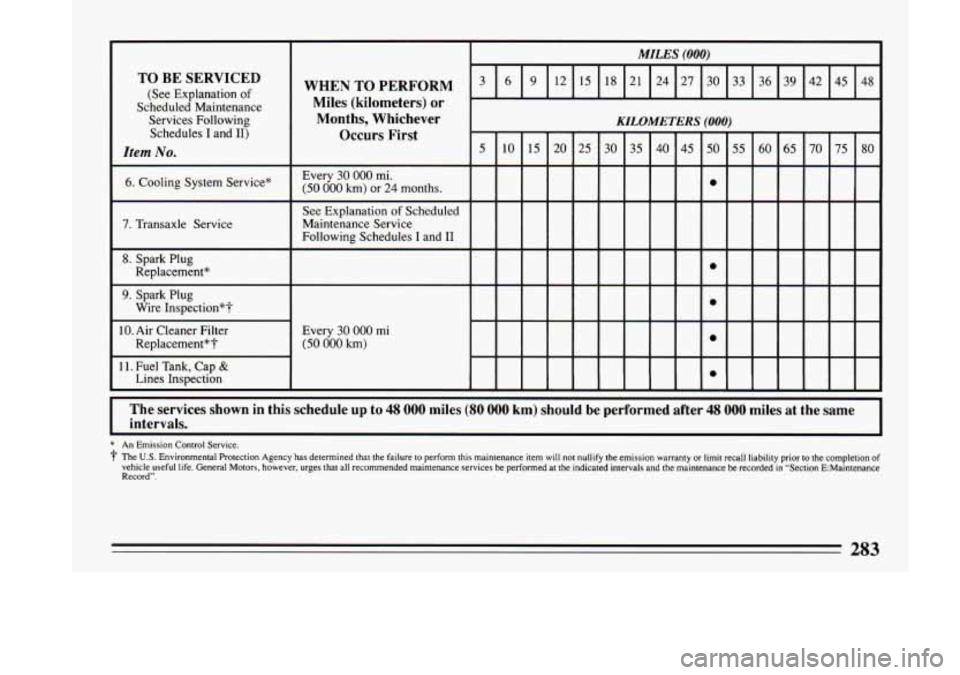
TO BE SERVICED
(See Explanation of
Scheduled Maintenance
Months, Whichever Services Following
Miles (kilometers) or
WHEN
TO PERFORM
Schedules I and
IIj
I Itern No.
Occurs First
I
7. Transaxle Service See
Explanation
of Scheduled
Maintenance Service
Following Schedules I and
I1
I 8. Spark~Plug ~
Replacement*
I 9. Wire Spark Inspection”?
10. Air Cleaner Filter
I Replacement*? I
Every 30 000 mi
(50 000 km)
11. Fuel Tank, Cap &
I Lines Inspection
MILES (000)
3
39 36 33
30 27
24 21 18 15 12 9 6
KILOMETERS (000)
50 55
0
0
0
0
0
60 65 70 75 80
The services
shown in this schedule up to 48 000 miles (80 000 km) should be performed after 48 000 miles at the same
intervals.
* An Emission Control Service.
The
U.S. Environmental Protection Agency has determined that the failure to perform this maintenance item will not nullify the emission warranty or limit recall liability prior to the completion of
vehicle useful life. General Motors, however, urges that all recommended maintenance services be performed at the indicated intervals and the maintenance be recorded in “Section EMaintenance
Record”.
283
Page 286 of 324
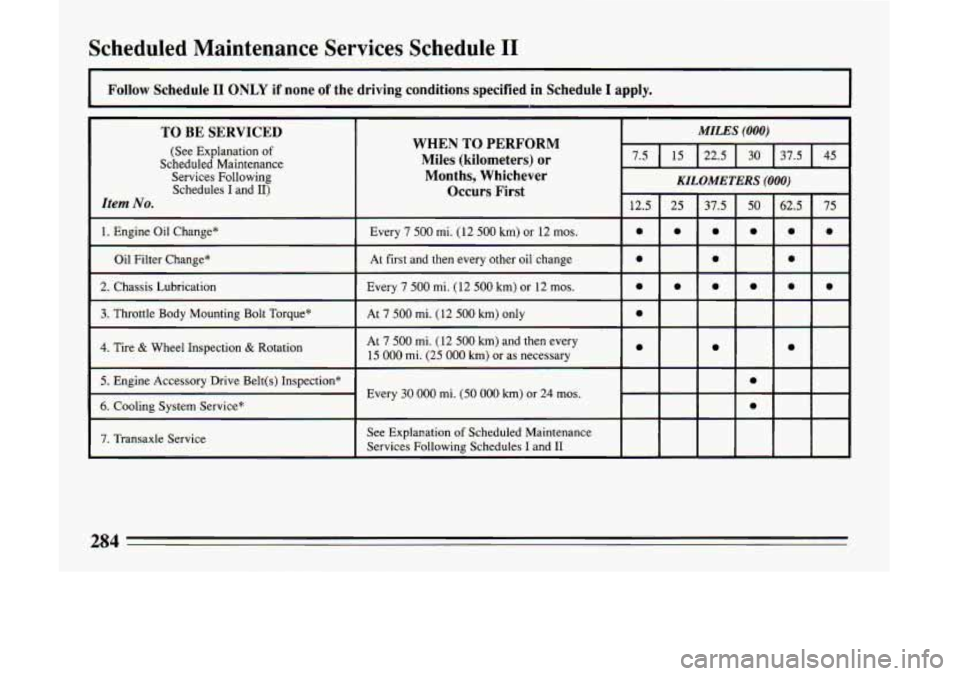
Scheduled Maintenance Services Schedule I1
Follow Schedule I1 ONLY if none of the driving conditions specified in Schedule I apply.
TO BE SERVICED
(See Explanation of
Scheduled Maintenance
Services Following Schedules
I and 11)
Item No.
1. Engine Oil Change"
Oil Filter Change"
2. Chassis Lubrication
3. Throttle Body Mounting Bolt Torque*
4. Tire & Wheel Inspection & Rotation
5. Engine Accessory Drive Belt(s) Inspection"
6. Cooling System Service*
7. Transaxle Service
WHEN TO PERFORM
Miles (kilometers) or
Months, Whichever
Occurs
First
MILES (000)
KILOMETERS (000)
I' I 12.5 I 25
Every
7 500 mi. (12 500 km) or 12 mos. 1.1.
At first and then every other oil change 1.1 ~~ ~
Every 7 500 mi. (12 500 km) or 12 mos.
I I
At 7 500 mi. (12 500 km) only 1.1
At 7 500 mi. (12 500 km) and then every
15
000 mi. (25 000 km) or as necessary
Every
30 000 mi. (50 000 km) or 24 mos.
H-
See Explanation of Scheduled Maintenance
Services Following Schedules
I and I1 I
284